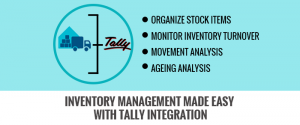 There are two critical aspects of the business. One is cash flow. Ignore it and you are likely to face a severely impacting cash crunch that can bring operations to a halt. The second is the inventory. If your business involves inventory then you need fine, granular control of inventory.
There are two critical aspects of the business. One is cash flow. Ignore it and you are likely to face a severely impacting cash crunch that can bring operations to a halt. The second is the inventory. If your business involves inventory then you need fine, granular control of inventory.
Fortunately, Tally ERP 9 software has a superb inventory management module that lives up to expectations. However, you can use its standard inventory control or opt for Tally customization that helps you do it more efficiently. Here are a few tips to improve efficiency in inventory management in Tally for 2020.
Track Entire Inventory
This is for you if you have hundreds of parts or items in inventory. The general practice is to have a standardized method to know a number of each item in your inventory and the total cost.
Improve efficiency with a little bit of Tally customization. Create heads for each item and allocate codes if possible to make it easier to manage inventory and let the code reflect in your invoice with Tally invoice customization. Assign a cost to each item and add up the total value of each item. You can go a step further and backtrack to analyze the movement of each item, frequency of movement and volume of movement. Add in a parameter to calculate interest loss on static inventory.
Calculate ratios of inventory items and costs. Next, you can also factor in the storage space each item occupies. All these are tiny factors but they will help you have in-depth knowledge that can become the basis for making better decisions on inventory maintenance and flow to optimize investments.
Audits
Once you put this system in place you will want to progress to the next step in efficient inventory management with the help of Tally 9 ERP software. You can carry out an audit in two ways. One is to simply use Tally’s feature to get an overall view of inventory and each item’s age factor as well as movement. The second way is to carry out a physical check. This should be done at least once in six months to detect any discrepancies in inventory. It will help you better categorize inventory and accordingly modify your inventory in Tally.
Categorization
It becomes easier to manage inventory when you categorize it into product types and sizes or according to value or according to movement or develop a custom method in Tally to get data on all of these parameters. Another useful inclusion in categorization is to identify products and customers and the frequency of orders.
A third way is to categorize inventory according to profits as a percentage in which you ignore the interest loss on storage and a percentage based on factoring in interest loss as well as the frequency of movement. This is important.
Let us assume your inventory is hypothecated to a bank and you pay monthly interest on inventory you carry. It should enter the equation to give a more precise picture of actual profits. You could even drill down to calculating space rental for each inventory item.
Price Movement
Include analytics to know your returns. Price may vary as you restock inventory. Price varies when you have the dead inventory you are forced to sell at a discount or even scrap it if it is obsolete or damaged.
Did you factor in freight as part of the cost of items you hold in inventory? Inbound freight and outbound freight charges must be factored in to help you get a clear picture of the actual cost of the item and your net profit. If you do not track all associated costs you may actually be making a loss on each sale and you do not even know about it until later.
Suppliers and Payments
From a general inventory management system to a detailed one you have so far progressed to specific details. Next, you tackle suppliers and their performance. You place orders on manufacturers and on traders. Delivery time varies and so does payment terms. In some cases, you may make advance payments and receive materials after a delay. Interest costs on such delays can eat into your profit. Further, a delay in supply could affect your delivery time to your customer.
Analyze suppliers in detail with Tally customization for inventory and you have a clear picture. You know at a glance the delay factor for each supplier. This helps you in deciding about replenishing stocks, whether of raw material or semi-finished or finished goods.
You may have more than one supplier for a particular component. This analysis will help you decide which one is better in terms of speed of delivery, quality, and returns. Customizing the inventory module of Tally, as you see, helps you reap benefits.
Inventory Is Tied To Sales
Tally ERP 9 software is your single point solution so why not tie together sales and inventory in more detail and in a better way with Tally customization. You can get experts to dissect your operations and perform improvements.
Tally invoice customization goes hand in hand with inventory customization. Include code for items in your invoice and that will help you get fast analytics of sales movement and profits on a regular basis and on seasonal basis. Further, tie in your order part as well. This way you will have a better view of where lack of inventory led to cancelled orders and how you can change this for better customer experience.
Sourcing at the right price is half of the story of profit-making. There are times when a supplier will announce price rises. In this case, the right inventory management practice should help you decide whether it is worthwhile buying items in bulk at existing price or allow the price increase to take place and continue with regular purchases.
Customization is an involved process and you will need the assistance of Tally experts like Smart Sight Innovations to customize inventory and other modules of Tally to bring about efficiency increases in 2020.













